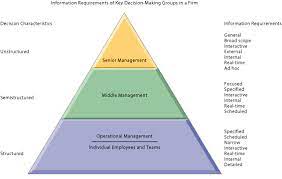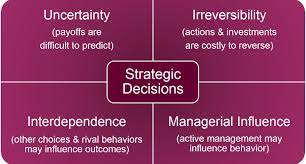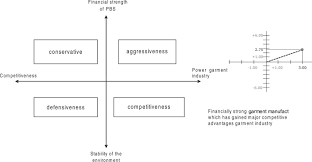5 Common Queries on Effective Strategic Decision Making
- What is the best way to make strategic decisions?
- How can I ensure my strategic decisions are effective?
- What factors should be considered when making strategic decisions?
- What tools can be used to make better strategic decisions?
- How can I evaluate the success of my strategic decisions?
What is the best way to make strategic decisions?
Making strategic decisions requires a thoughtful and systematic approach. Here are some steps that can help you make effective strategic decisions:
- Define the problem or opportunity: Clearly define the problem or opportunity you are trying to address. This will help you focus your efforts and avoid wasting time on irrelevant issues.
- Gather information: Collect as much relevant information as possible about the problem or opportunity. This may involve conducting research, analyzing data, and consulting with experts.
- Identify options: Generate a range of options for addressing the problem or opportunity. Consider both short-term and long-term solutions, as well as the potential risks and benefits of each option.
- Evaluate options: Evaluate each option based on its feasibility, effectiveness, and alignment with your goals and values.
- Make a decision: Select the option that best meets your needs and aligns with your goals and values.
- Develop an action plan: Develop an action plan that outlines the steps needed to implement your decision effectively.
- Monitor progress: Regularly monitor progress to ensure that your decision is achieving the desired outcomes, and be prepared to adjust your approach if necessary.
Remember that making strategic decisions is an ongoing process, not a one-time event. By following these steps, you can make better-informed decisions that will help you achieve your goals over time.
How can I ensure my strategic decisions are effective?
Ensuring that your strategic decisions are effective requires careful planning, analysis, and execution. Here are some steps you can take to increase the chances of success:
Define your goals: Clearly identify what you want to achieve with your strategic decision. This will help you stay focused and make sure that all of your efforts are directed towards achieving that goal.
Gather data: Collect as much relevant information as possible about the situation, including market trends, customer preferences, and competitor strategies. The more information you have, the better informed your decision will be.
Analyze the data: Once you have collected the data, analyze it carefully to identify patterns and trends that can inform your decision-making process.
Consider different options: Brainstorm a variety of different options for achieving your goal and evaluate each one based on its potential impact, feasibility, and cost.
Make a decision: Based on your analysis and evaluation of different options, make a decision about which strategy to pursue.
Develop an action plan: Once you have made a decision, develop a detailed action plan for executing it successfully.
Monitor progress: Regularly monitor progress towards achieving your goals and adjust your strategy if necessary based on feedback from customers or changes in the market environment.
By following these steps, you can increase the likelihood that your strategic decisions will be effective in achieving your desired outcomes.
What factors should be considered when making strategic decisions?
When making strategic decisions, there are several factors that should be taken into consideration. These include:
- Company goals and objectives: The first factor to consider is the company’s overall goals and objectives. Strategic decisions should align with these goals in order to ensure that the company is moving in the right direction.
- Market trends and competition: It is important to keep an eye on market trends and competition when making strategic decisions. This can help you identify opportunities and threats, and make informed decisions.
- Resources: The resources available to the company, including finances, personnel, and technology, should also be considered when making strategic decisions.
- Risk tolerance: Every decision involves some level of risk, so it is important to consider the company’s risk tolerance when making strategic decisions.
- Stakeholder interests: The interests of stakeholders, including investors, employees, customers, and suppliers, should also be taken into account when making strategic decisions.
- Legal and regulatory environment: The legal and regulatory environment can have a significant impact on strategic decisions, so it is important to stay up-to-date on any changes or developments in this area.
By considering these factors when making strategic decisions, companies can make informed choices that will help them achieve their goals while minimizing risk and maximizing opportunities for success.
What tools can be used to make better strategic decisions?
There are several tools that can be used to make better strategic decisions. Here are some of the most commonly used ones:
SWOT Analysis: This tool helps identify an organization’s strengths, weaknesses, opportunities, and threats. By analyzing these factors, decision-makers can make informed choices about the direction of the organization.
PESTEL Analysis: This tool looks at the Political, Economic, Sociocultural, Technological, Environmental and Legal factors that may impact an organization. It helps decision-makers identify external factors that may affect their business.
Decision Matrix: A decision matrix is a tool used to evaluate and prioritize different options based on a set of criteria. It helps decision-makers compare different options and choose the best one based on specific criteria.
Scenario Planning: Scenario planning is a technique used to anticipate future events and plan accordingly. Decision-makers create multiple scenarios based on different assumptions and analyze how each scenario would impact their business.
Cost-Benefit Analysis: This tool helps decision-makers evaluate the costs and benefits of different options before making a decision. It helps ensure that decisions are made in a financially responsible manner.
Game Theory: Game theory is a mathematical approach to decision-making that analyzes how people make decisions in competitive situations. It can be useful in situations where multiple parties are involved in making strategic decisions.
These tools can be used individually or in combination with each other depending on the situation at hand. By using these tools, decision-makers can make more informed choices about the direction of their organization or business strategy.
How can I evaluate the success of my strategic decisions?
Evaluating the success of your strategic decisions is an important part of the decision-making process. Here are some ways to evaluate the success of your strategic decisions:
Set clear goals: When making strategic decisions, it is important to set clear and measurable goals. This will help you to evaluate the success of your decisions by comparing the actual results with the expected results.
Monitor progress: Keep track of progress towards achieving your goals on a regular basis. This will help you to identify any potential issues or challenges that may arise and take corrective action as needed.
Collect feedback: Collect feedback from stakeholders, customers, and employees to determine how well your strategic decisions are being received and implemented.
Analyze data: Use data analysis techniques to measure the impact of your strategic decisions on key performance indicators (KPIs) such as revenue, profit margins, customer satisfaction, etc.
Review regularly: Regularly review and analyze the success of your strategic decisions to identify areas for improvement and make necessary adjustments.
By following these steps, you can effectively evaluate the success of your strategic decisions and make informed decisions in the future.




